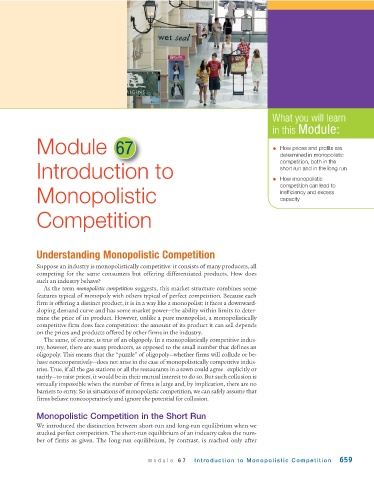Page 701 - Krugmans Economics for AP Text Book_Neat
P. 701
What you will learn
in this Module:
Module 67 • How prices and profits are
determined in monopolistic
competition, both in the
Introduction to short run and in the long run
• How monopolistic
competition can lead to
Monopolistic inefficiency and excess
capacity
Competition
Understanding Monopolistic Competition
Suppose an industry is monopolistically competitive: it consists of many producers, all
competing for the same consumers but offering differentiated products. How does
such an industry behave?
As the term monopolistic competition suggests, this market structure combines some
features typical of monopoly with others typical of perfect competition. Because each
firm is offering a distinct product, it is in a way like a monopolist: it faces a downward-
sloping demand curve and has some market power—the ability within limits to deter-
mine the price of its product. However, unlike a pure monopolist, a monopolistically
competitive firm does face competition: the amount of its product it can sell depends
on the prices and products offered by other firms in the industry.
The same, of course, is true of an oligopoly. In a monopolistically competitive indus-
try, however, there are many producers, as opposed to the small number that defines an
oligopoly. This means that the “puzzle” of oligopoly—whether firms will collude or be-
have noncooperatively—does not arise in the case of monopolistically competitive indus-
tries. True, if all the gas stations or all the restaurants in a town could agree—explicitly or
tacitly—to raise prices, it would be in their mutual interest to do so. But such collusion is
virtually impossible when the number of firms is large and, by implication, there are no
barriers to entry. So in situations of monopolistic competition, we can safely assume that
firms behave noncooperatively and ignore the potential for collusion.
Monopolistic Competition in the Short Run
We introduced the distinction between short-run and long-run equilibrium when we
studied perfect competition. The short-run equilibrium of an industry takes the num-
ber of firms as given. The long-run equilibrium, by contrast, is reached only after
module 67 Introduction to Monopolistic Competition 659

